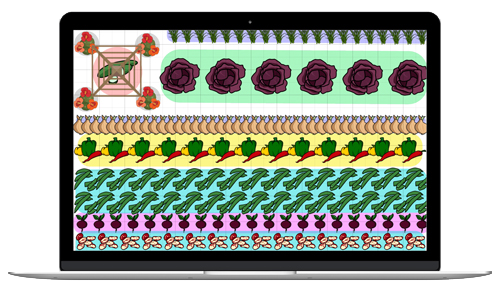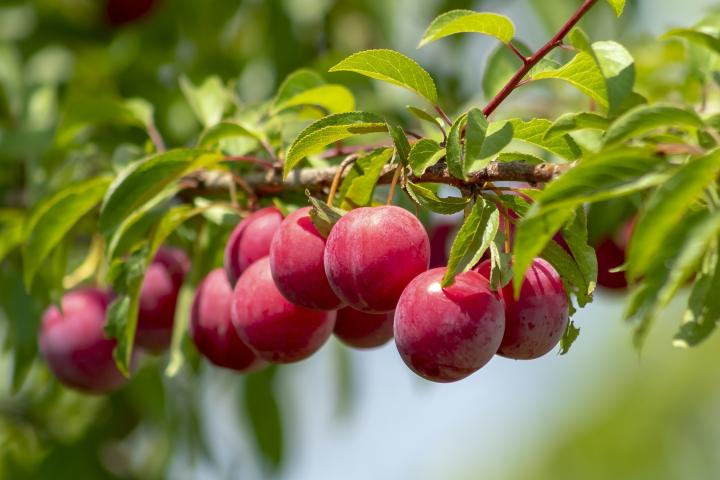
Planting, Growing, and Harvesting Plums
The Almanac Garden Planner - Use It Free for 7 Days!
Plan your 2025 garden with our award-winning Garden Planner.
Types
- For a European type, try the ‘Stanley’. This semi-freestone type works great for the eastern, midwestern, and some of the northwest regions of the U.S. It is self-fertile, meaning no cross-pollination is necessary. It’s harvested in late August, producing medium to large plums with dark blue skin and greenish-yellow flesh and is great for cooking, canning, or eating fresh.
- For a Japanese type, try the ‘Satsuma’, which produces large, dark-red plums. This kind is good for eating fresh and canning because of its sweet taste.
- American hybrid trees, such as ‘Alderman’, ‘Superior’, and ‘Underwood’, are all popular choices. These trees combine the taste of the Japanese variety with the hardiness of the European variety. These types work well for regional extremes.
Cooking Notes
- Plums are great for making jams or jellies.
- Plums can also be stored through freezing or drying them (dried plums are prunes), learn how to dry fruit with a dehydrator.
ADVERTISEMENT
This article does not describe how to prune or when to pick American Hybrid varieties. Which is what I have.
Hi S,
You should plan to prune your plum trees in late winter/early spring, after the coldest part of the winter has passed, but before buds break and new growth occurs. When pruning is done during the summer or fall, it can reduce dormancy and can potentially cause damage to your plum trees, especially when there is an early winter.
When pruning, start by removing and dead, damaged, or diseased branches. Then remove branches to allow for more light to penetrate, increase fruit quality, and encourage new branch development. You should also prune off suckers coming from the rootstock and vegetative water sprouts growing straight up from main branches.
Harvesting plums will take place in summer into fall (depending on your growing area). You should allow the plums to ripen on the tree as they will not gain sweetness once picked. One indicator is if you press on the skin and it is slightly soft to the touch. If you are unsure, pick one and try it to see what if the taste is to your liking.
Hope this helps!
I don't know the type of plum tree i have, but it's rather large and produces a lot of plums. We have this black fungus that keeps growing on the branches every year. We have tried neam oil and neam pesticide, which have not worked.
I purchased a Hollywood variety for my Seattle area home, and now realize I need a 2nd variety for x-pollination. The next closest location for the 2nd tree would be about 100' away. Is that too far for an effective x-pollination sibling?
Thanks
The recommended maximum distance between plum trees is 50 feet, but as long as there are plenty of pollinators in your area, 100 feet shouldn’t be too far. You may just end up with fewer plums than ideal—but that’s better than no plums!
My Stanley Plum Tree dropped over half its unripened fruit in early July and then dropped more in August. It does not appear diseased. Is that a sign of lack of fertilizer or hot weather? Or some other reason?
I have been having this same problem for the last few years. I have tried watering, 10-10-10 and citrus fertilizer to no avail.
My trees are loaded and when the fruit is about half size they begin falling off.
I am in mid S.C. And the trees are in full sun.
I am having the same issues with my two peach trees.
Any ideas of what I should do.
Best time to plant
That’s unfortunate. It’s unlikelly to be too much or too little fertilizer. Premature fruit drop is common among fruit trees; it’s Mother Nature’s way of reducing the load—especially if you do not thin the fruit load yourself (prune when plums are about 3/4-inch long, leaving 4 to 6 inches between remaining fruits). Weather could be a factor; high heat in early spring can stress the tree, and if conditions in general have been dry, the tree may not be well irrigated.
I'm in zone 4 and two years ago bought a home with two plum trees on the property. They are quite large, have lovely, fragrant blooms in early spring, but have produced no fruit at all. What could be wrong? The trees are healthy looking with no sign of pests or disease. Help?











